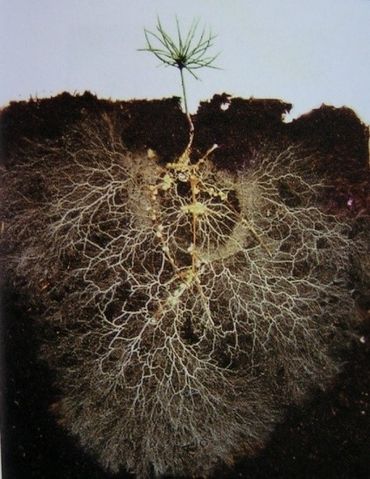
Soils may reduce the impact of drought, or enhance damage
Wageningen Environmental Research
The researchers show to which degree plants in Europe are affected by extreme drought and heat. They do this by determining the green index of plants with the use of satellite images. “The greenness of a plant can be seen as a degree of its productivity”, explains Dr Titia Mulder, working at the Soil Geography and Landscape Group at WUR and first author of the recent scientific article. “Whenever greenness reduces in times of extreme heat and drought, this means that the plant is less productive and also gets damaged by the drought." The researchers analysed 26 years of monthly assembled data from remote sensing of the green cover by plants in the whole of Europe, between 1982 and 2008. These data have subsequently been linked to the monthly meteorological data.
More resistance against climate change through symbiosis
Soils with unfavourable growing conditions may enhance the effects that extreme heat and drought have on the greenness of plants and may slow down their recovery. For example, the plant can be unable to reach groundwater because of root depth limitations, or because the topsoil in itself is too shallow. Plants on a ‘favourable soil’ are more resilient because of the presence of clay particles, organic material and a good water retention capacity. Especially the presence of symbiotic relations between plants and soil life, for example mycorrhiza, is very important for plants to be resilient when it comes to a changing climate. Such a symbiotic network allows specialised plant groups to still obtain their life necessities.
Greenness from plant cover reduces by 31 percent
 All over Europe, the greenness of plants decreases by 31 percent because of extreme heat and drought. The difference in green is at its peak after one month and remains apparent for around four months. The decline in productivity strongly depends on climate, vegetation and soil type of the area. Plants in Southern Europe are generally less hampered by extreme heat and drought than vegetation in Northern Europe. The Mediterranean shows the least impact on greenness, because the plants there have adapted to a dry and warm climate. As a consequence, these areas are less green, making them overall less productive and a smaller CO2 sink than areas in more northern parts that have a colder and more wet climate. Especially these areas, foremost in the taiga and boreal forests, appear to be very sensitive to extreme drought and heat.
All over Europe, the greenness of plants decreases by 31 percent because of extreme heat and drought. The difference in green is at its peak after one month and remains apparent for around four months. The decline in productivity strongly depends on climate, vegetation and soil type of the area. Plants in Southern Europe are generally less hampered by extreme heat and drought than vegetation in Northern Europe. The Mediterranean shows the least impact on greenness, because the plants there have adapted to a dry and warm climate. As a consequence, these areas are less green, making them overall less productive and a smaller CO2 sink than areas in more northern parts that have a colder and more wet climate. Especially these areas, foremost in the taiga and boreal forests, appear to be very sensitive to extreme drought and heat.
Climate resilient future
In the future, we are expected to have more extreme events of heat and drought. This can make productive ecosystems like in Northern and Eastern Europe unstable, and less capable to absorb CO2. It is important that climate policies for the future will be directed towards maintaining and creating a healthy ecosystem and soil functioning, especially in vulnerable ecosystems.
Text: Wageningen Environmental Research
Pictures: Wageningen Environmental Research; Rachael Kowaleski
